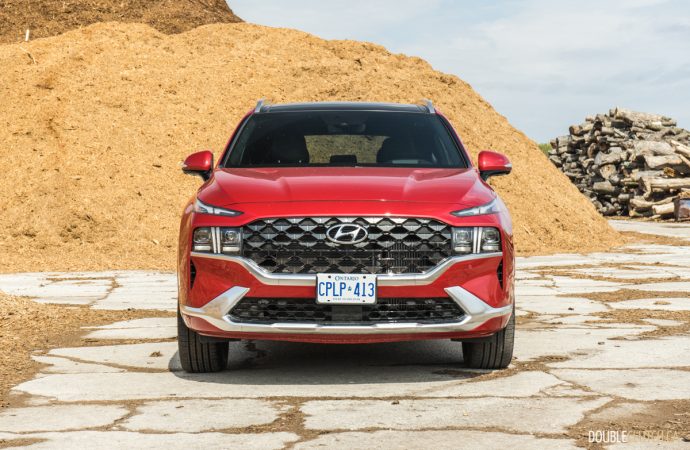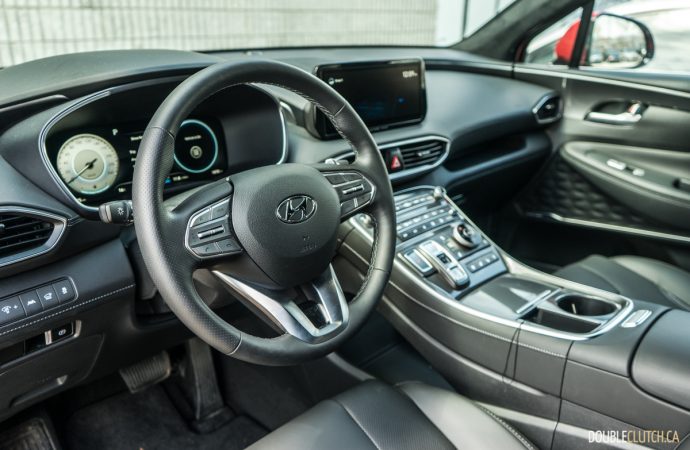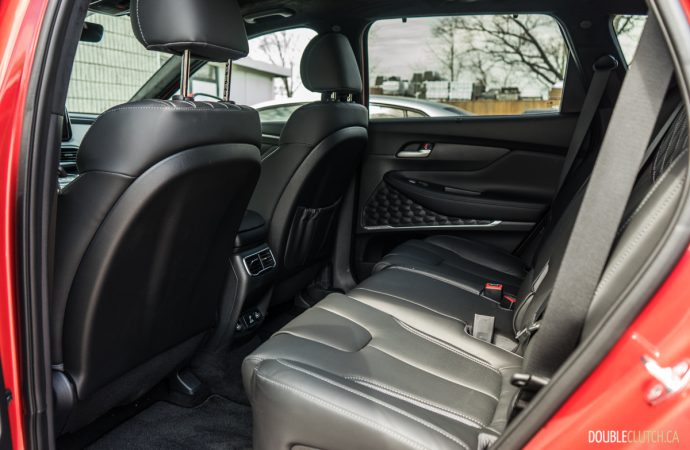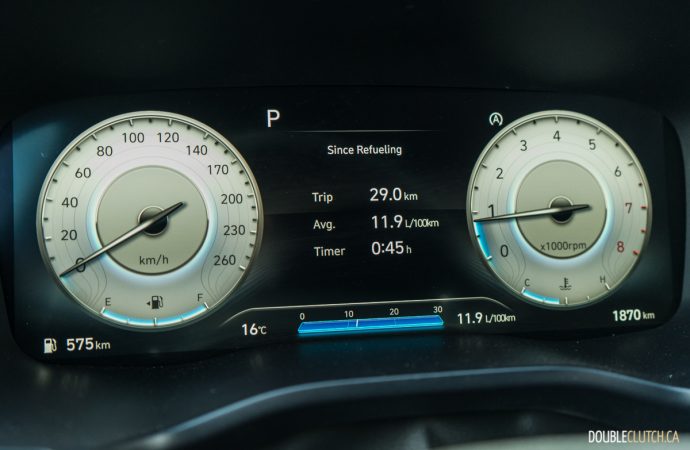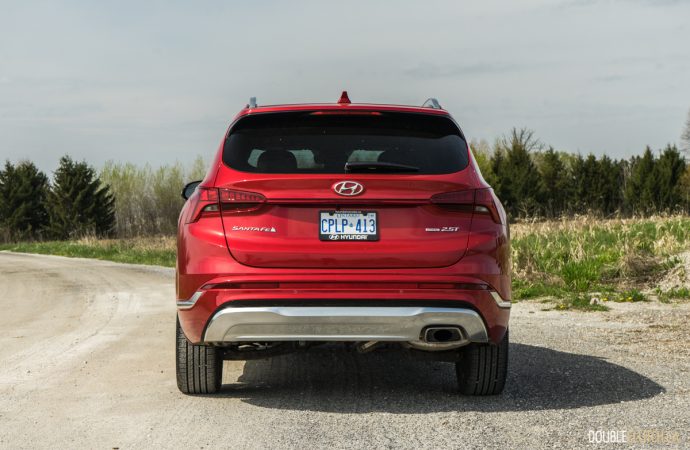The Hyundai Santa Fe, one of the most popular midsized crossovers in the segment, enjoyed a total ground-up redesign in 2019. Now, for 2021, the hyper-competitive segment keeps marching forward, so Hyundai is keeping their contender in the game with another round of big updates. New powertrains, new trim levels, a new look and re-worked interior are here for the latest model year. We spent a week with a top of the line 2021 Hyundai Santa Fe Calligraphy.
The exterior of the 2021 Santa Fe has been freshened with very bold front-end styling shared with the new Tucson, and resembling the luxurious Genesis lineup. Most notable is the wide, three-dimensional grille with the T-shaped LED lighting. A aggressive crease line runs the length of the body and connects the front and rear LEDs. Changes at the back are less obvious, but there are revised taillights and large reflectors built into the lower fascia.
Our top of the line Calligraphy trim tester came standard with new 19-inch alloy wheels with a bit of a retro style to them, though 20-inch rims are an available option. All of these revisions lead to a Santa Fe that’s more eye catching and distinctive. It may not be to everyone’s taste, especially more conservative buyers, but on the flip side it should help garner the Santa Fe some more attention in a seemingly endless list of competitors.
Inside the Santa Fe, the most obvious update is the center console, now a floating unit which frees up additional storage underneath. The simple and elegant dash is similar to prior model years; dominated by the central touch screen (10.25 or 12.3-inches), only now all controls including climate, radio, and even push-button gear selection are on the new console borrowed from the Palisade. I am not a fan of the console; it’s cluttered with a lot of similar looking buttons which makes it difficult to get used to. The two cup holders are on the small side and awkwardly placed in staggered positions and at different heights.
The USB ports are buried at the bottom of a cubby right next to the cupholder, which is not only prime for spill damage, but requires drivers to remove anything in the cubby to access them. There’s also issue with the placement of the USB ports and 115V outlet in the second row. They are located at the back of the console where the plugs can easily get kicked by careless passengers and require a reach to access them. It’s worth mentioning that unlike its main rival and platform-mate, the new Kia Sorento, the Santa Fe does not offer a third row.
My gripes with the new console aside, the interior in the Santa Fe is quite a nice family space. Deep door pockets for storage, and plenty of head and legroom for passengers in the rear heated seats, which easily recline for even more comfort. Up front, the quilted Nappa leather heated and cooled seats, standard on the Calligraphy, are a great place to melt away the miles. Of course, a huge panoramic sunroof is also standard on the Calligraphy and available in other trims.
Cargo room is solid for the segment, and the 60/40 split rear seats fold perfectly flat, even remotely from push buttons in the cargo area, to help move larger things. The Calligraphy model comes with a very nice faux-suede headliner, a very welcome touch of class, complete with matching pillar covers. The headliner and soft leather seats do make the Santa Fe’s interior feel more upscale, and overall fit and finish is strong, though the space is let-down by the use of cheap shiny plastics on high-touch areas like the console and door panels. Still, for a CUV that tops out well under $50,000, it’s a good looking interior.
The biggest news for the Santa Fe this year is what’s under the hood, three totally new powertrains that offer something for everyone. For starters, the base engine is now the 2.5-liter four-cylinder, producing 191 horsepower and 182 lb-ft.of torque, paired to an eight-speed automatic. There’s a new hybrid consisting of a 1.6-liter turbocharged four paired to a lithium-ion 64-kWh battery, and an electric motor. Combined output comes to an estimated 225 horsepower and 195 lb-ft. of torque, and the power flows to all four wheels through a traditional six-speed automatic.
Finally, the top-dog tested here is now a turbocharged version of the 2.5-liter Smartstream turbocharged four-cylinder making a very healthy 277 hp and 311 lb-ft. of torque. Interestingly, the turbo 2.5L is paired with an eight-speed dual clutch transmission which flows power to all four wheels through Hyundai’s HTRAC AWD system.
This motor accelerates with surprising authority and makes light work of highway passing without sounded strained. It’s certainly one of the more refined four-cylinders in the segment and gives the Santa Fe a bit more character behind the wheel. The eight-speed dual clutch gearbox is an odd choice in this package, and there are some early reports of it being cumbersome in the city. For mostly highway and typical suburban streets, we found no major issues. It’s a little abrupt off the line, even if you ease into the gas, but offers crisp quick shifts that match the personality of the turbo-four well.
Dynamically, the Santa Fe is more engaging to drive than many of its competitors, though it’s not quite as much fun as the Mazda CX-5. The steering is light and responsive with fairly sharp turn-in; we griped about the lack of any steering feel in 2019 and while there still isn’t much, it does seem that Hyundai has made some improvements in this regard. The suspension is well-mannered on the highway, but in the city it is easily upset by ruts and other bumps. That said, road noise is well mitigated which helps the Santa Fe feel a bit more premium.
Fuel economy with the new turbocharged 2.5-liter is adequate at best. After a week of mixed driving we observed 10.9L/100km, which is pretty solid for an all-wheel-drive crossover of this size and power, just not as impressive as I had hoped for the brand new powertrain. Naturally, it accepts 87-octane regular fuel for optimal performance and efficiency.
Pricing has crept up a bit too, though we still consider the Santa Fe to be one of the best bargains in the segment. A front-drive Essential starts at $31,399, and the Preferred trim, which is likely to be the volume seller kicks off at $36,399. The Preferred delivers dual zone climate control and proximity key, and can be optioned up with a long list of selectable individual options and packages, including an upgrade to the hybrid powertrain.
A healthy $43,799 gets you into the more upscale Luxury Hybrid trim which adds more gadgets and of course the hybrid powerplant. Finally, the top-of-the-line Calligraphy with its 2.5-liter turbocharged engine and massive list of features, gadgets and luxuries comes in at $47,499.
The Calligraphy’s price is a big ask for a Santa Fe. As well equipped and pleasant it is to live with, that price point opens up a lot of other options that make this a tough sell. That said, the 2021 Hyundai Santa Fe Calligraphy is certainly one of the best equipped and better driving mid-sized crossovers on the market. The performance from the new engine might just take enough of the sting away from the price to make it a viable option for families looking for a practical hauler without sacrificing on luxuries.

